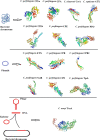Vaccination against pathogenic clostridia in animals: a review
- PMID: 33891221
- PMCID: PMC8062623
- DOI: 10.1007/s11250-021-02728-w
Vaccination against pathogenic clostridia in animals: a review
Abstract
Clostridium is a Gram-positive, rod-shaped, anaerobic, and spore-forming bacterium, which is found in the surrounding environments throughout the world. Clostridium species cause botulism, tetanus, enterotoxaemia, gas gangrene, necrotic enteritis, pseudomembranous colitis, blackleg, and black disease. Clostridium infection causes severe economic losses in livestock and poultry industries. Vaccination seems to be an effective way to control Clostridial diseases. This review discusses the toxins and vaccine development of the most common pathogenic Clostridium species in animals, including Clostridium perfringens, Clostridium novyi, Clostridium chauvoei, and Clostridium septicum. In this comprehensive study, we will review different kinds of clostridial toxins and the vaccines that are experimentally or practically available and will give a short description on each vaccine focusing on its applications, advantages, and disadvantages.
Keywords: Clostridium; Immunogenic; Toxin; Vaccine; Veterinary.
Conflict of interest statement
The authors declare no competing interests.
Figures
References
-
- Ardehali M, Darakhshan H. Production and standardization of polyvalent Clostridium perfringens vaccine in Iran. Developments in biological standardization. 1976;32:31–34. - PubMed
Publication types
MeSH terms
Supplementary concepts
LinkOut - more resources
Full Text Sources
Other Literature Sources


